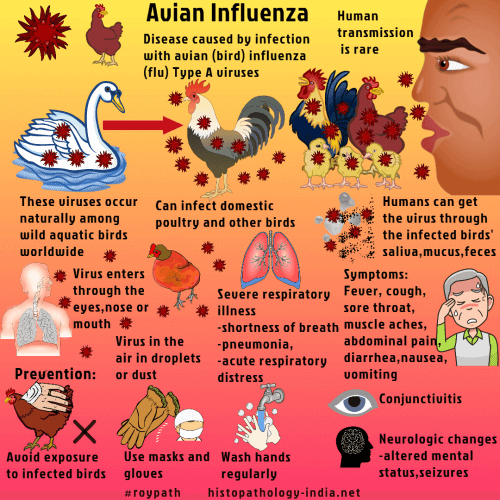|

Custom Search
|
|
Infectious Disease Online Pathology of Avian Influenza (Bird Flu)
|

|
It is an infection caused by avian (bird) influenza (flu) viruses. These viruses occur naturally among wild birds worldwide in their intestines, but they do not get sick. It is very contagious among birds including domestic birds eg. chickens, ducks and turkeys and kill them. Virus are excreted from infected birds in their saliva, nasal secretions, and feces. Birds including domestic ones become infected through direct contact with other infected poultry, or through contact with infected surfaces (such as dirt or cages) or materials (such as water or feed). It causes two main forms of diseases in poultry. The "low pathogenic" form go undetected and causes only mild symptoms (such as ruffled feathers and a drop in egg production). The "high pathogenic" form spreads rapidly through flocks of poultry, affecting multiple internal organs and has a mortality rate that can reach 90-100% often within 48 hours. Cases of Human infection :Confirmed cases of human infection from several subtypes have been reported since 1997. In most cases human infection have resulted from contact with infected poultry (Example: domesticated chicken, ducks, and turkeys) or surfaces contaminated with secretion/excretions from infected birds. The spread from one ill person to another is very rare. “Human influenza virus” are those subtypes that spread widely among humans. There are only three known A subtypes of influenza viruses (H1N1, H1N2, and H3N2).Viruses are constantly changing, and they adapt over time to infect and spread among humans. Symptoms vary from typical human influenza-like symptoms (e.g., fever, cough, sore throat, and muscle aches) to eye infections, pneumonia, severe respiratory diseases (such as acute respiratory distress). Avian Influenza A (H5N1): Subtype Influenza A “H5N1 virus” that occurs mainly in birds, is highly contagious and are deadly to them. Infections with these viruses have also occurred man. Human health risks during the H5N1 outbreak: In the outbreaks in Asia and Europe more than half of those infected with this virus have died. Most cases have occurred in previously healthy children and young adults. So far, the spread of H5N1 virus from person to person has not been recorded. Because viruses have the ability to change, one day it could be able to infect men and spread easily from one person to another. In that case an influenza pandemic (worldwide outbreak of disease) could begin. Avian Influenza A (H7N9) virus:
Treatment: The H5N1 virus that has caused human illness and death in Asia is resistant to amantadine and rimantadine, two antiviral medications commonly used for influenza. Two other antiviral medications, oseltamavir and zanamavir, would probably work to treat influenza caused by H5N1 virus, but additional studies still need to be done to demonstrate their effectiveness. Antiviral drugs like Tamiflu and Relenza block the flu virus from escaping an infected cell and spreading further. But the drugs have to be taken within 48 hours of getting the flu. H5N1 mutates rapidly and has a history of being able to acquire genes from viruses infecting other animal species. It can cause severe disease in humans ; Laboratory studies have demonstrated that isolates from this virus have a high pathogenicity and can cause severe disease in humans ; Birds that survive infection excrete virus for at least 10 days making it easier to spread the virus at live poultry markets and by migratory birds.
|
|
Archive: World wide
spread of the disease in 2006 In October 2005, H5N1 was confirmed to have spread to fowl in Romania and Turkey. As of 9th February 2006, 165 people are infected in seven countries, Thailand, Vietnam, Cambodia, Indonesia, China, Turkey and most recently Iraq. 88 of these have subsequently died. There have been conflicting reports in Egypt, the government said Friday that there had been seven cases in three provinces Egypt's agriculture minister, said on Saturday that the number of cases of bird flu in the country are not high enough to warrant large-scale slaughter of birds. India and France both confirmed their first outbreak of the deadly strain of bird flu among fowl in 2006. India: Tens of thousands of chickens had died from bird flu in western India. Officials began slaughtering 500,000 birds in a 1.5-mile radius around the poultry farms in the town of Navapur ( It is a small town roughly 200 miles north-northeast of India's most populous city, Mumbai, formerly known as Bombay) where the confirmed cases were detected, said the minister for animal husbandry of Maharashtra. People suffering from flu-like symptoms in the region were tested for the infection. Some 750,000 vaccines was rushed in to vaccinate other poultry in Maharashtra, as a precaution. An unknown number of people in the area were reportedly suffering from flu and fever, and scientists were to start testing them on them according to the National Institute of Virology in Pune.
|
| Advice
to travellers in case of outbreaks of the disease : If you are visiting countries with reported outbreaks of H5N1 bird flu among poultry, you should observe the following measures: - do not visit bird or poultry farms or markets - avoid close contact with live or dead (raw) poultry - do not eat raw or poorly-cooked poultry or poultry products, including blood - wash your hands frequently with soap and water
|
|
|
Visit:- Dermatopathology Online

|
Copyright © 2022 histopathology-india.net
